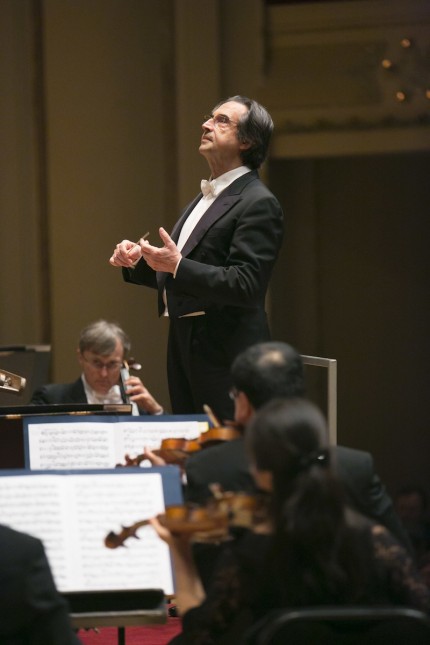Muti artfully draws parallels between late Mozart and middle Beethoven

After the previous week’s Chicago Symphony Orchestra performances of the Bach Mass in B minor that saw Riccardo Muti favoring large forces and slower tempos, it was somewhat of a surprise that his traversal of Vivaldi’s Concerto in A Major for Strings and Continuo, R. 158, which opened Friday afternoon’s Chicago Symphony program, zipped along at a fairly brisk clip with a mere nineteen players.
The string sound was robust and expressively vibratoed, a far cry from the leaner, straight-toned Baroque sound so often employed these days. The middle movement was unusually tranquil and introspective yet never losing its wonderful sense of line. The finale had Muti slightly muting repeats to create a delightful echo effect.
Mozart has been a relative rarity in Muti’s music directorship thus far, with only one previous Mozart symphony having been performed here, in the first weeks of his tenure. In many respects, Mozart’s Symphony No. 38, Prague, K. 504, seems tailor-made for a conductor so associated with opera, foreshadowing Don Giovanni as it does, which would also premiere in Prague. Muti treated it like a symphonic mini-opera with a foreboding opening that sped up and built up dramatic momentum before expanding dynamically.
The Andante spotlighted the wonderful balance between stings and woodwinds, which were by and large treated antiphonally. The finale had touches of wit and Mediterranean sunshine laced in with Sturm und Drang.
Although Beethoven’s Fourth Symphony remains one of the least performed of the Beethoven symphonies, Muti seemed determined to make a fresh case for it and managed to do so admirably.
The introduction was unusually slow, the build-up and long pauses pregnant with a tension that was palpable before the music joyously breaks forth from minor to major.
The Adagio was much faster than expected but featured plenty of rubato to slow things down as needed, particularly as solo winds took the spotlight phrase by phrase in the climax, always with an emphasis on playing in a lyrical manner.
The upsurge to the finale with restless strings riding into a satisfying climax that gave forth to a coda with zany slow downs and a frenzied ending that revealed the Fourth Symphony to be nearly as radical a piece as the far more popular and titanic Fifth Symphony.
By juxtaposing late Mozart with middle period Beethoven, employing only slightly larger forces for the Beethoven and observing all repeats in both and being so flexible with tempos, a fascinating trajectory and continuum began to emerge: some twenty years apart, Mozart’s Prague Symphony represents culminating Classicism while the Beethoven Fourth Symphony signifies expansive Classicism already bursting into early Romanticism.
The program will be repeated 7:30 p.m. Tuesday; 312-294-3000; cso.org.
Posted in Performances




